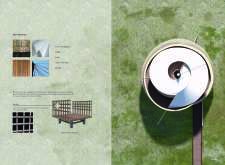5 key facts about this project
The observation tower at Al Wathba Wetland Reserve provides an inviting space for visitors to connect with nature. Positioned within a rich ecological area, it functions as both a viewing platform and a place for reflection. The design merges traditional Arabic architectural themes with modern environmental practices, creating a structure that honors local culture while addressing climate challenges.
Design Engagement
The spiral ascent of the tower is a prominent element that encourages interaction with the surrounding environment. This design allows visitors to see the wetland from various heights, promoting exploration and engagement with nature. The consideration of eye heights for both standing and sitting positions ensures that the space is open to all, enhancing accessibility for families and individuals of different ages.
Thermal Comfort Strategies
In response to the harsh climate of Abu Dhabi, the design employs strategies for thermal comfort through effective shading and natural ventilation. The spiral form of the tower creates a natural updraft that aids airflow, making the interior more comfortable. A tensile membrane canopy shields visitors from direct sunlight, contributing to a pleasant atmosphere throughout the year.
Cultural Integration
Cultural elements are woven into the tower’s design, notably through the use of mashrabiya in the handrails and central canopy. This traditional feature adds a layer of cultural significance while enriching the visual appeal. By incorporating local design elements, the structure connects with the region's heritage, offering visitors an experience that is deeply linked to the local landscape.
Material Sustainability
The materials chosen for the tower reflect a commitment to sustainability and ecological awareness. Key components include PTFE fiberglass, steel, and palm-tree leaf timber, all of which work together to enhance the structure’s performance and aesthetic quality. Using local materials demonstrates an effective approach to meet both functional needs and design goals.
The tower’s façade exhibits intricate patterns inspired by regional designs, allowing light to create varying effects as the day progresses. This dynamic interaction between light and shadow informs the visual experience, prompting visitors to appreciate both the architectural details and the environmental surroundings.






















































